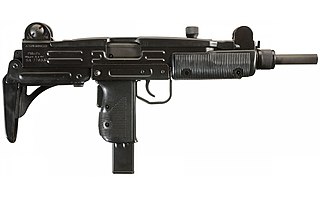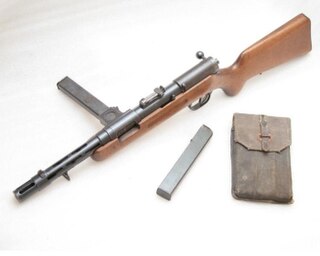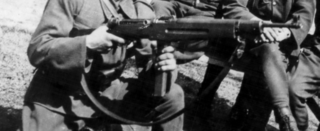
A firearm is any type of gun that uses an explosive charge and is designed to be readily carried and used by an individual. The term is legally defined further in different countries.

A machine gun (MG) is a fully automatic, rifled auto-loading firearm designed for sustained direct fire with rifle cartridges. Other automatic firearms such as automatic shotguns and automatic rifles (including assault rifles and battle rifles) are typically designed more for firing short bursts rather than continuous firepower and are not considered true machine guns. Submachine guns fire handgun cartridges rather than rifle cartridges, therefore they are not considered machine guns, while automatic firearms of 20 mm (0.79 in) caliber or more are classified as autocannons rather than machine guns.

A machine pistol is an autoloading pistol capable of fully automatic fire, including stockless handgun-style submachine guns.

A submachine gun (SMG) is a magazine-fed automatic carbine designed to fire handgun cartridges. The term "submachine gun" was coined by John T. Thompson, the inventor of the Thompson submachine gun, to describe its design concept as an automatic firearm with notably less firepower than a machine gun. As a machine gun must fire rifle cartridges to be classified as such, submachine guns are not considered machine guns.

The Uzi is a family of Israeli open-bolt, blowback-operated submachine guns and machine pistols first designed by Major Uziel "Uzi" Gal in the late 1940s, shortly after the establishment of the State of Israel. It is one of the first weapons to incorporate a telescoping bolt design, which allows the magazine to be housed in the pistol grip for a shorter weapon.

The STEN is a British submachine gun chambered in 9×19mm which was used extensively by British and Commonwealth forces throughout World War II and post war including the Korean War. The Sten was a simple design with very low production cost for mass production to meet demand for submachine guns.
A semi-automatic firearm, also called a self-loading or autoloading firearm, is a repeating firearm whose action mechanism automatically loads a following round of cartridge into the chamber and prepares it for subsequent firing, but requires the shooter to manually actuate the trigger in order to discharge each shot. Typically, this involves the weapon's action utilizing the excess energy released during the preceding shot to unlock and move the bolt, extracting and ejecting the spent cartridge case from the chamber, re-cocking the firing mechanism, and loading a new cartridge into the firing chamber, all without input from the user. To fire again, however, the user must actively release the trigger, allow it to "reset", before pulling the trigger again to fire off the next round. As a result, each trigger pull only discharges a single round from a semi-automatic weapon, as opposed to a fully automatic weapon, which will shoot continuously as long as the ammunition is replete and the trigger is kept depressed.

The .45 Reising submachine gun was manufactured by Harrington & Richardson (H&R) Arms Company in Worcester, Massachusetts, USA, and was designed and patented by Eugene Reising in 1940. The three versions of the weapon were the Model 50, the folding stock Model 55, and the semiautomatic Model 60 rifle. Over 100,000 Reisings were ordered during World War II, and were initially used by the United States Navy, Marine Corps, and the United States Coast Guard, though some were shipped to Canadian, Soviet, and other allied forces to fight the Axis powers.

A firearm is said to fire from an open bolt if, when ready to fire, the bolt and working parts are held to the rear of the receiver, with no round in the chamber. When the trigger is actuated, the bolt travels forward, feeds a cartridge from the magazine or belt into the chamber, and fires that cartridge in the same movement. Like any other self-loading design, the action is cycled by the energy released from the propellant, which sends the bolt back to the rear, compressing the mainspring in readiness for firing the next round. In an open-bolt gun firing semi-automatically, the bolt is caught and held at this point by the sear after each shot; and in automatic open-bolt fire, it's caught and held in this manner whenever the trigger is released. In contrast to this, in closed-bolt guns, the trigger and sear do not affect the movement of the bolt directly.
Blowback is a system of operation for self-loading firearms that obtains energy from the motion of the cartridge case as it is pushed to the rear by expanding gas created by the ignition of the propellant charge.

The PM-63 RAK is a Polish 9×18mm submachine gun, designed by Piotr Wilniewczyc in cooperation with Tadeusz Bednarski, Grzegorz Czubak and Marian Wakalski. The RAK combines the characteristics of a self-loading pistol and a fully automatic submachine gun.

The MP35 was a submachine gun used by the Wehrmacht, Waffen-SS and German police both before and during World War II. It was developed in the early 1930s by Emil Bergmann and manufactured at the Bergmann company in Suhl.

The Shipka is a 9mm Bulgarian submachine gun produced in 1996 by the Bulgarian company Arsenal. The name is a reference to the famous Shipka Pass, near Arsenal's Kazanlak headquarters, in the Balkans where Bulgarian volunteers and Russian troops defeated the Ottoman Empire during the Russo-Turkish War of 1877, thereby liberating Bulgaria. The Shipka was developed for the Bulgarian police and military.

The Danuvia 39M/43M was a Hungarian submachine gun designed by Pál Király in the late 1930s and used during World War II.
The MP34 is a submachine gun (SMG) that was manufactured by Waffenfabrik Steyr as Steyr-Solothurn S1-100 and used by the Austrian Army and Austrian Gendarmerie and subsequently by units of the German Army and the Waffen SS, in World War II. An exceptionally well-made weapon, it was used by some forces well into the 1970s.

The Jatimatic is a Finnish 9×19mm Parabellum submachine gun developed in the late 1970s and early 1980s by Jali Timari. The submachine gun made its debut in 1983. The Jatimatic was manufactured in very limited numbers initially by Tampereen Asepaja Oy of Tampere and later—Oy Golden Gun Ltd. The firearm was designed primarily for police, security forces and armored vehicle crews. It was never adopted into service by the Finnish Defence Forces, although the later GG-95 PDW version was tested by the FDF in the 1990s.

The Pistola Mitragliatrice Fiat Mod. 1915, commonly nicknamed the Villar Perosa, was an Italian portable automatic weapon developed during World War I by the Officine di Villar Perosa.

The M3 is an American .45-caliber submachine gun adopted by the U.S. Army on 12 December 1942, as the United States Submachine Gun, Cal. .45, M3. The M3 was chambered for the same .45 ACP round fired by the Thompson submachine gun, but was cheaper to mass produce and lighter, at the expense of accuracy. The M3 was commonly referred to as the "Grease Gun" or simply "the Greaser," owing to its visual similarity to the mechanic's tool.

The PPS is a family of Soviet submachine guns chambered in 7.62×25mm Tokarev, developed by Alexei Sudayev as a low-cost personal defense weapon for reconnaissance units, vehicle crews and support service personnel.
The Maschinenkarabiner 36 is a prototype German 9mm submachine gun developed by Hugo Schmeisser.
















